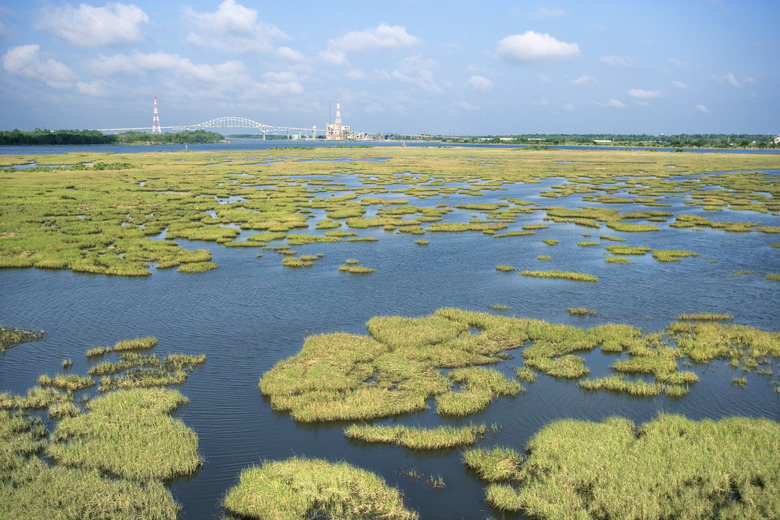Environmental Problems Associated With Coastal & Inland Wetlands
You might think that swamps aren't worth the land they sit on. Yet, those swamps and similar wetlands protect the environment and make life better for people and wildlife. Wetlands are locations where water is on or above the soil some or all of the time. They can be found inland away from the oceans or along the Pacific, Alaskan, Gulf and Atlantic coasts. Nature and humans cause problems that negatively affect wetlands.
Wetlands Along the Coasts
Wetlands Along the Coasts
Survey the contiguous United States, and you'll find about 40 million acres of wetlands on or near the coasts. Of these, 81 percent lie in the Southeast. Mangrove swamps, fresh-water marshes and salt marshes are a few of the types of coastal wetlands. The U.S. Environmental Protection Agency reports that coastal wetlands in the eastern part of the U.S. are disappearing twice as fast as they can restore themselves.
Protection From the Storm
Protection From the Storm
Coastal wetlands reduce the impact of storm surges and protect land that lies further inland during storms. These storms and high winds also damage coastal wetlands, filling them with debris and breaking the wetlands apart. Rising sea levels may affect coastal wetlands as well. The South Carolina Department of Natural Resources notes that hurricanes can provide slow erosion to wetlands, or they can replenish them with sediment.
Changes in Hydrology
Changes in Hydrology
Rural and urban development is essential to human progress, but those activities can change the hydrology of nearby wetlands. Hydrology refers to the way that water moves in relation to the land. Construction and development can withdraw water from a wetland or cause excess water to flow into one as a result of increased runoff. Although these changes occur mostly in freshwater wetlands, this type of stress on coastal wetlands is significant because more than 50 percent of the people in the U.S. live in coastal counties.
Erosion Problems
Erosion Problems
If you live near coastal wetlands, you may see problems such as erosion. Erosion, along with flooding, can occur when storms come onshore and sea levels rise. These types of wetland problems are intensified by changes in climate that cause an increase in the number of storms. Shoreline armoring, a method where people protect shores with physical structures, can have negative effects such as restricting the way sediments along the shore move naturally. When that happens, some marine organisms lose their habitats.
Inland Wetlands
Inland Wetlands
Different types of inland wetlands occur in locations such as basins, around lakes and along streams and rivers. People in Alaska may live near tundra wetlands, while residents in the Northeast might have bogs nearby. Many inland wetlands hold water for only part of the year. However, even when they're dry, they are important habitats for wildlife.
Inland Wetlands Problems
Inland Wetlands Problems
Inland wetlands can experience flooding problems similar to those that occur in coastal wetlands. Climate and temperature changes may alter the way inland wetlands function and change their distribution along the landscape. For instance, a precipitation increase caused by climate change can cause flooding in inland wetlands. These types of problems are detrimental because inland waterways are the only places where some swamp rose plants, wood ducks and other types of life exist. Some migrating birds use inland wetlands for breeding and nesting.
Inland Hydrology Changes
Inland Hydrology Changes
As people build homes or buildings, materials from construction can enter wetlands. Construction activities can also drain wetlands and change their hydrology. When people build roads or other types of barriers that restrict water flow, they can alter an inland wetland's hydrology. For example, the EPA describes how a dam built to control floods caused hydrology changes to the Mississippi River, causing the area to lose wetlands.
References
- U.S. Environmental Protection Agency: What Are Wetlands?
- U.S. Environmental Protection Agency: Coastal Wetlands
- U.S. Environmental Protection Agency: What Is a Watershed?
- South Carolina Department of Natural Resources: Conserving Wetlands, Protecting the Coast
- Wetlands; William J. Mitsch, James G. Gosselink
- U.S. Environmental Protection Agency: Great Lakes Ecosystem
- National Oceanic and Atmospheric Administration: "Armoring" Is the Practice of Using Physical Structures to Protect Shorelines From Coastal Erosion
- U.S. Environmental Protection Agency: Challenges and Approaches | Estuaries and Coastal Watersheds
Cite This Article
MLA
Lee, Kevin. "Environmental Problems Associated With Coastal & Inland Wetlands" sciencing.com, https://www.sciencing.com/environmental-problems-associated-coastal-inland-wetlands-23457/. 24 April 2017.
APA
Lee, Kevin. (2017, April 24). Environmental Problems Associated With Coastal & Inland Wetlands. sciencing.com. Retrieved from https://www.sciencing.com/environmental-problems-associated-coastal-inland-wetlands-23457/
Chicago
Lee, Kevin. Environmental Problems Associated With Coastal & Inland Wetlands last modified August 30, 2022. https://www.sciencing.com/environmental-problems-associated-coastal-inland-wetlands-23457/
